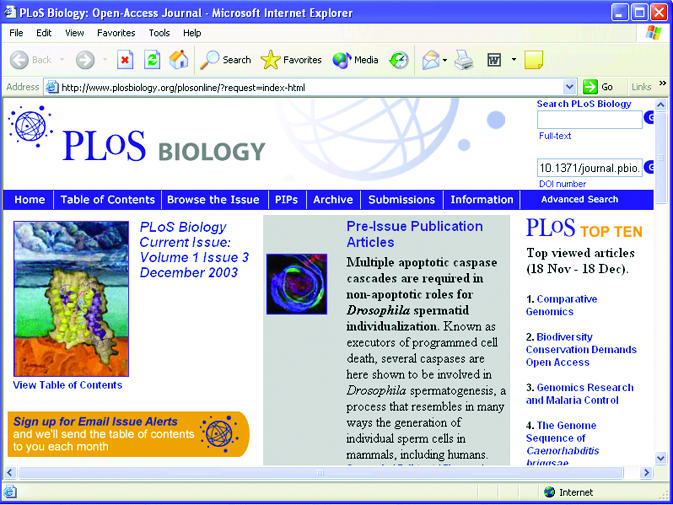Short abstract
An open access online journal from the Public Library of Science; first issue October 2003
ISSN 1544 9173 www.plosbiology.org
Rating: ★★★★
What an extraordinary time it is in scientific and medical publishing. These pages and many others have documented the increasing tension between traditional publishers and their audience in recent years. The essence of the problem is that readers have become dependent on easy-to-search, universally accessible electronic archives, which are owned by publishers, unlike old printed copies. If institutions stop current subscriptions, they also lose access to old issues. Publishers therefore seem to be free to charge what they like for access—and there is a perception that some are exploiting this position to the limit. Large profits from the publication of scientific journals have been reported.
Figure 1.

Brave new publishing world: the print journal and, below, the online version
Several initiatives to break out from this have involved establishing a different model of publishing, in which there is no charge for access to published papers. Instead, authors or their host institutions are charged pre-publication. Inevitably these initiatives have been primarily electronic, for reasons of cost. But the kudos accrued by publishing in the established journals, and the requirement for high impact publications, has slowed their development. BioMed Central is the largest of these initiatives, currently with 107 online journals. It has been strongly supported by some institutions, including UK universities and the NHS, which will pay publication costs for their authors. Unfortunately it has not yet attracted much high-impact science or medicine.
The Public Library of Science (PLOS) was born from a high-profile movement of academics and authors who in 2001 attempted to pressurise publishers to make all articles unconditionally free within six months of publication. Publishers did not oblige, so PLOS moved to the next stage, creating its own journals using this model. PLOS Biology is the first. It is freely available to all over the internet. Costs of production are met by a publication fee of several hundred dollars. More than BioMed Central, articles look as if they come from a paper journal, attributed to a specific issue and with page numbers. There are also short reviews of recent research in various areas, often of topical interest, and a promising “unsolved mystery” section.
Figure 2.

Well, how good is it? On the basis of the first two issues, it is very good indeed. There is a fascinating mix of commentary, short review articles, and full scientific research papers. The research articles are of impressive quality and relevance, covering, for example, malaria and diabetes genes, neural development, T cell signalling, and circadian rhythms. This feels like a really serious, well produced and high-science general biology journal. You will want to read many of the short articles and look in detail at some of the scientific ones. Such browsing is easier with a paper copy, and you can get one for a reasonable $160 (same price for institutions) for 12 issues. It is worth doing so, as it looks great.
On this evidence there seems a real prospect that PLOS Biology could be mould breaking, if it can maintain this scientific quality. It deserves to succeed. PLOS Medicine is due to launch in 2004.
Items reviewed are rated on a 4 star scale (4=excellent)


